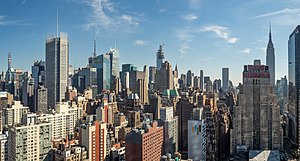
Back منطقة الأعمال المركزية Arabic Mərkəzi biznes rayonu Azerbaijani Central business district BCL কেন্দ্রীয় বাণিজ্যিক এলাকা Bengali/Bangla Central business district Catalan Innenstadt German Distrito financiero Spanish Ärikeskus Estonian Finantza barrutia Basque ناحیه تجاری مرکزی Persian

A central business district (CBD) is the commercial and business center of a city. It contains commercial space and offices, and in larger cities will often be described as a financial district. Geographically, it often coincides with the "city centre" or "downtown". However, these concepts are not necessarily synonymous: many cities have a central business district located away from its traditional city center, and there may be multiple CBDs within a single urban area. The CBD will often be highly accessible and have a large variety and concentration of specialised goods and services compared to other parts of the city.[1] Midtown Manhattan is the world's largest central business district.

In Chicago, the Chicago Loop is the second-largest central business district in the United States. It is also referred to as the core of the city's downtown.
Mexico City also has its own historic city center, the colonial era "Centro Histórico", along with two CBDs: the mid-late 20th century Paseo de la Reforma in Polanco, and the new Santa Fe, respectively. Russia's largest central business district is the Moscow International Business Center in Moscow.
The shape and type of a central business district almost always closely reflect the city's history. Cities with strong preservation laws and maximum building height restrictions to retain the character of the historic and cultural core may have a CBD quite a distance from the city centre (and in some cases, outside the city limits itself). This distinction is quite common in European cities such as Paris, Moscow, Vienna, Prague and Budapest. The New World grew quickly after the emergence of modern transport, therefore a single centre often included many of the region's tallest buildings and served as both a commercial and cultural city centre.

In the 21st century, increasing urbanisation has led to the development of megacities that often have multiple CBDs scattered across the urban area. Downtown sections of cities, especially in North America, often are distinct from CBDs and city centres.[2] No two CBDs have the same spatial shape, but there are certain common geometric patterns, which are largely a result of centralised commercial and industrial activities.[3]
- ^ Murphy, Raymond E. (1972). The Central Business District: A Study in Urban Geography (chapter 1). Routledge. ISBN 978-1-351-48543-2. Archived from the original on 22 April 2023. Retrieved 14 March 2023.
- ^ "Reviving American downtowns Archived 20 December 2007 at the Wayback Machine". The Economist. 1 March 2007.
- ^ Hartman, George W. (1950). "The Central Business District--A Study in Urban Geography". Economic Geography. 26 (4): 237–244. doi:10.2307/141260. JSTOR 141260.